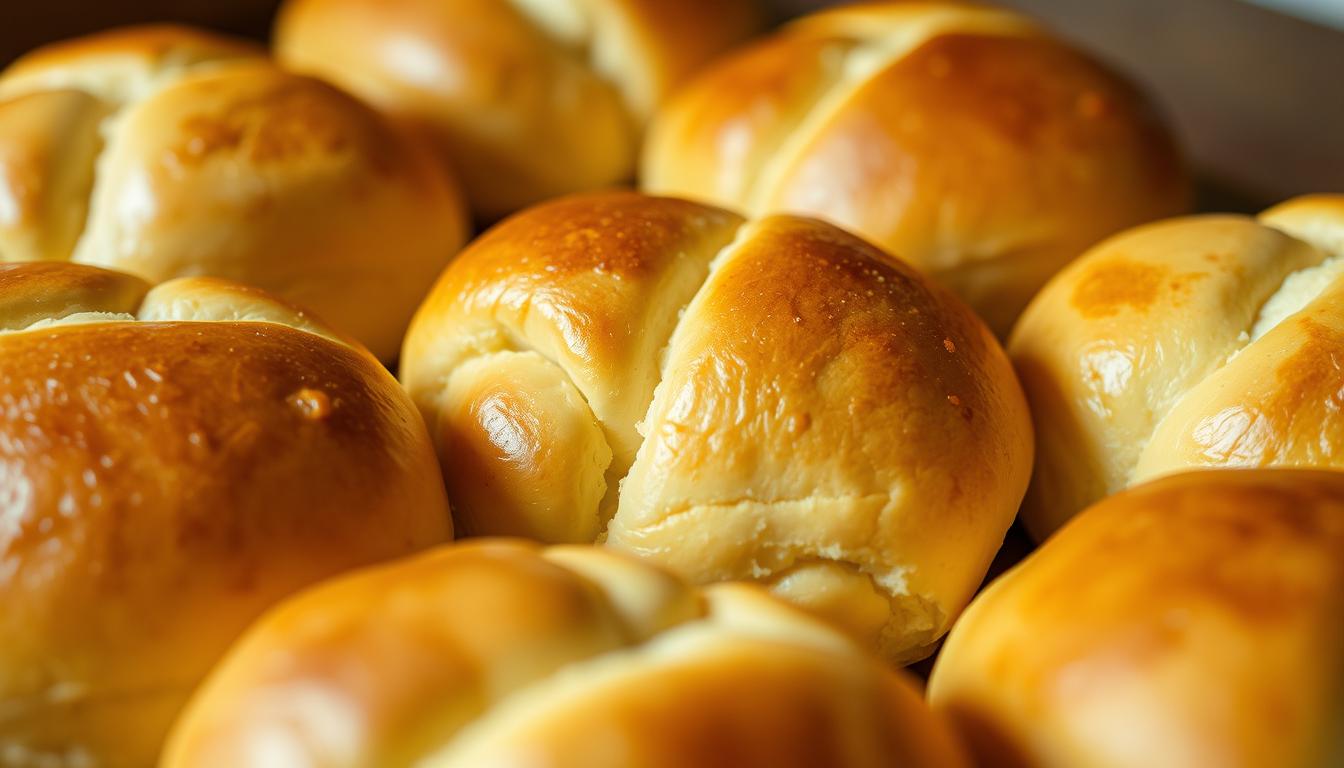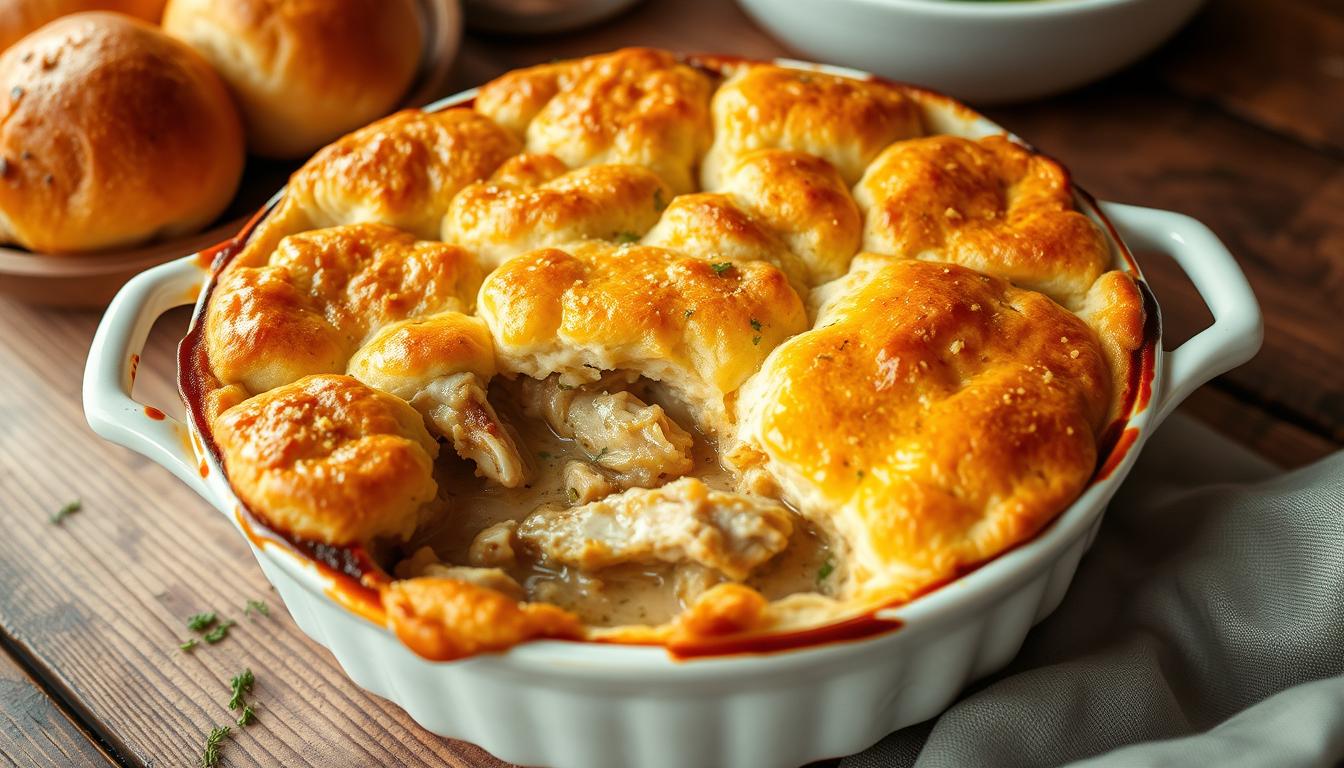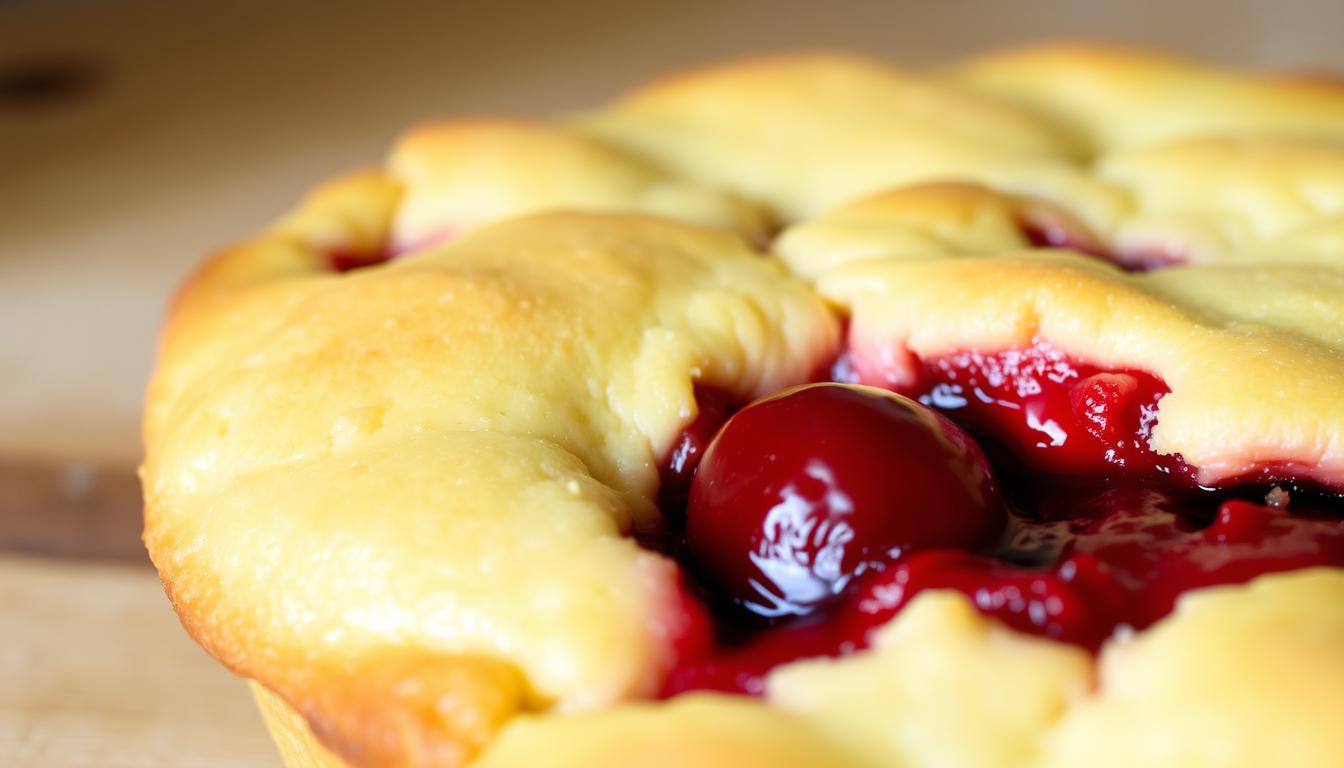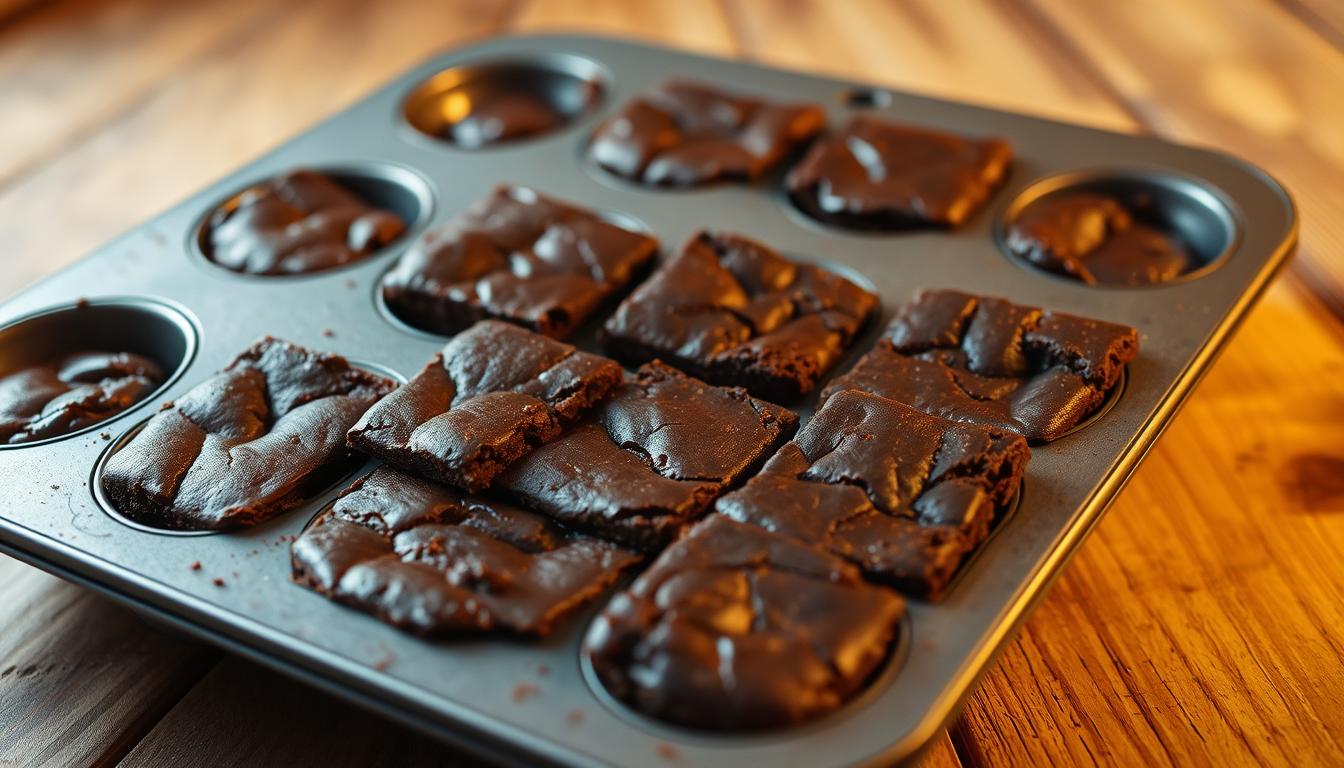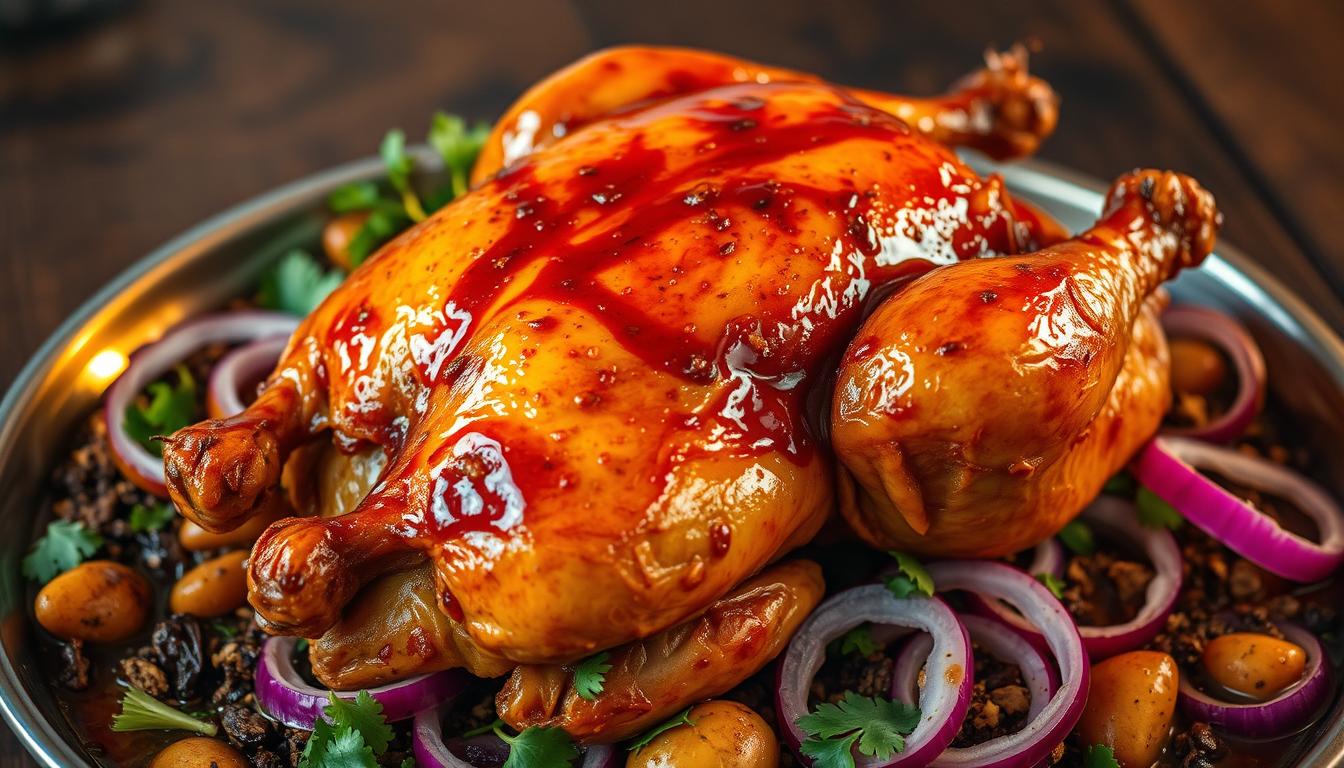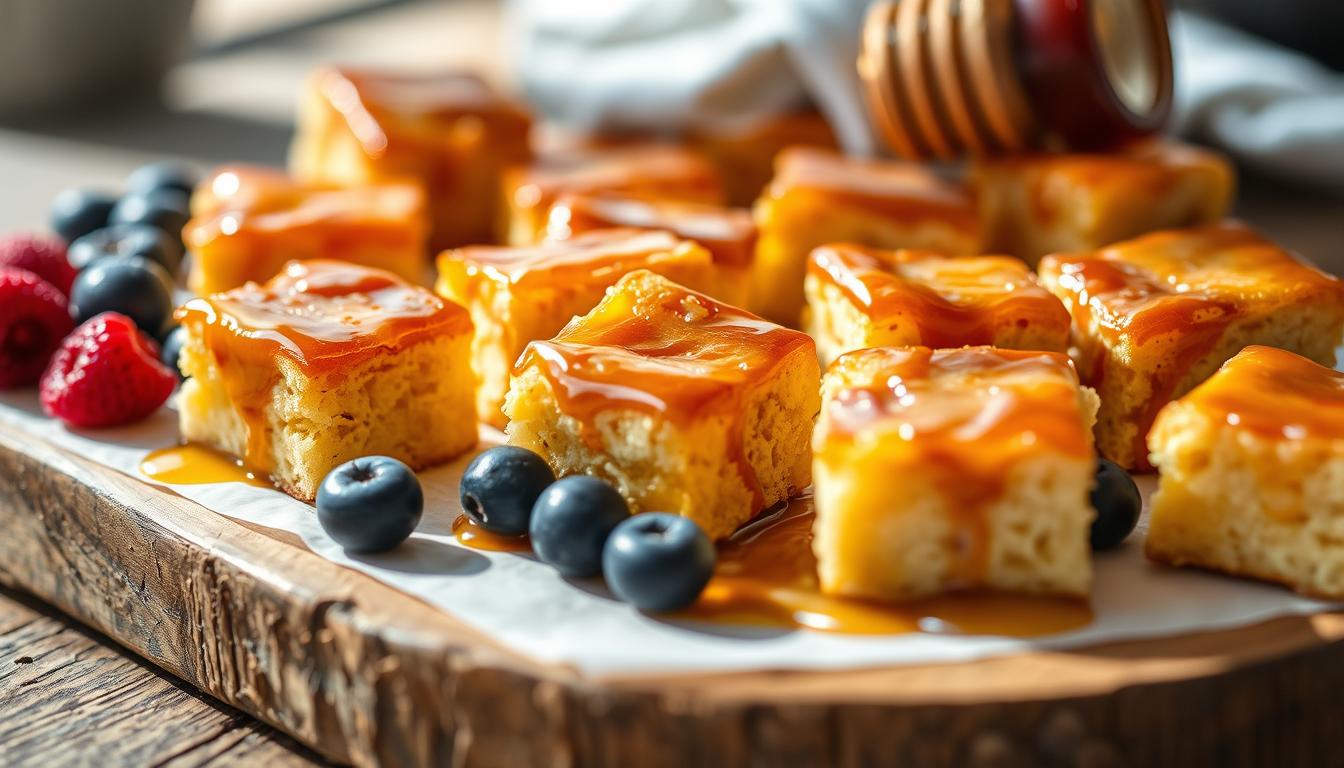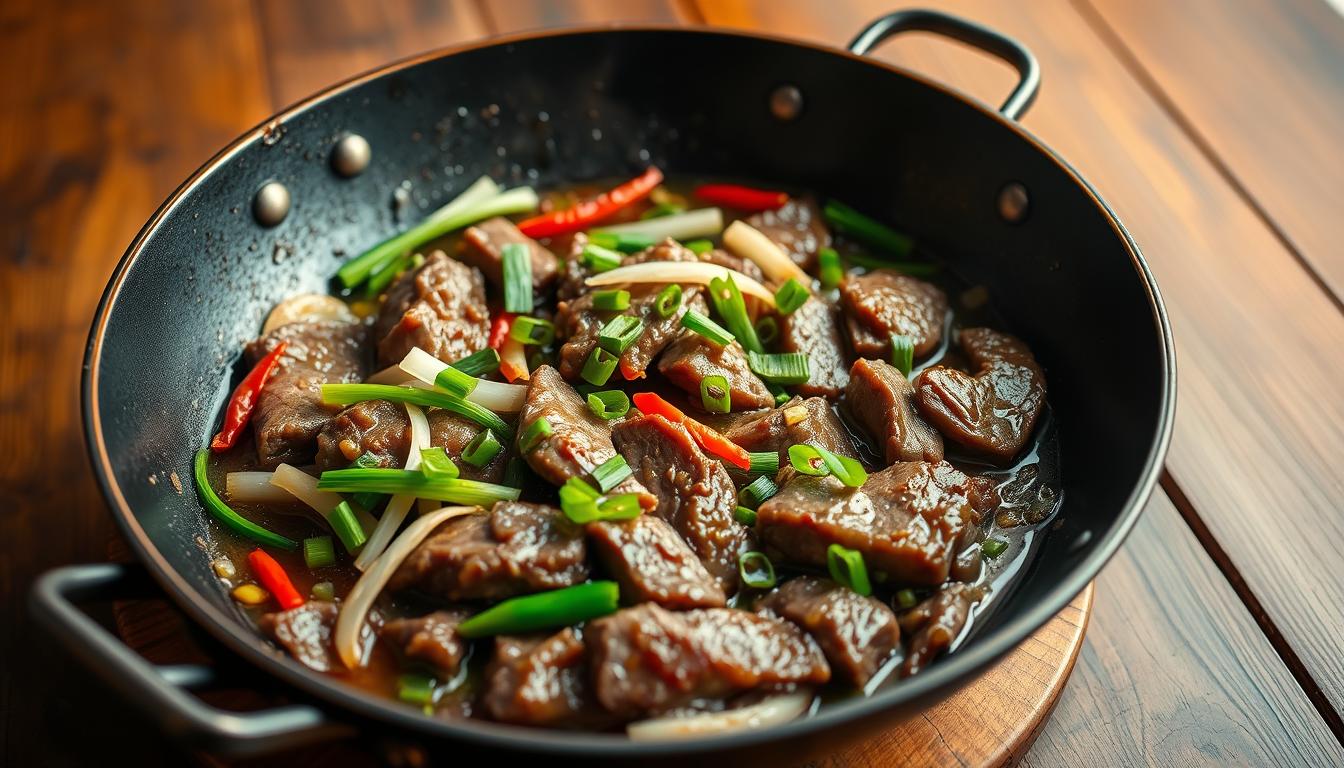The first time I pulled a batch of golden milk brioche rolls from the oven, the kitchen filled with an aroma that reminded me of my grandmother’s bakery. Those soft, pillowy brioche rolls were more than just a recipe. They were a connection to generations of baking passion.
Milk is key in making milk brioche rolls tender and rich. When you understand the science behind it, you’ll see how 3/4 cup of warm milk can change your baking.
Brioche rolls are not just ordinary bread. They are a culinary masterpiece with a delicate texture and deep flavor. The milk’s protein structure works with flour and yeast to create a luxurious crumb. This crumb melts in your mouth, making these rolls a true delight.
Key Takeaways
- Milk contributes critical moisture to brioche rolls
- Warm milk activates yeast for optimal rise
- Protein in milk helps develop soft, tender texture
- Fat content enhances flavor and richness
- Temperature of milk impacts dough development
The Essence of Milk in Baking
Milk is key in making the perfect milk brioche. It changes how you bake. Milk is a standout ingredient in your kitchen.
Nutritional Value of Milk
In a milk brioche recipe, milk is more than just a liquid. It’s packed with nutrients that boost flavor and texture. Here’s why milk is so important:
- Protein for structural development
- Natural sugars for subtle sweetness
- Fat content for rich, tender crumb
- Minerals supporting yeast activation
Flavor Enhancement
Milk does more than hydrate your dough. It introduces a depth of flavor that water can’t match. The natural sugars caramelize, making a golden-brown crust with a complex taste.
Moisture Retention
The secret to soft brioche rolls is milk’s moisture. Using 3/4 cup of warm milk ensures a tender, pillowy texture. Milk proteins keep moisture in, making your rolls fresh and delicious.
Baking is a science, and milk is your delicious laboratory assistant!
Understanding Brioche: A Brief Overview
Brioche rolls have won the hearts of many with their rich history and soft texture. These sweet brioche bun recipes come from French traditions. They show the highest level of bread-making skill.
The story of brioche is a journey into the art of cooking. It started in France in the 15th century. These rolls quickly became known for their advanced baking techniques.
Origins and Cultural Significance
Brioche rolls are more than just bread. They have unique qualities that make them stand out:
- High butter and egg content
- Rich, golden color
- Soft, tender crumb
- Slightly sweet flavor profile
Distinctive Characteristics
Brioche rolls are versatile. You can enjoy them at any time:
| Meal Type | Serving Suggestion |
|---|---|
| Breakfast | Paired with jam or butter |
| Coffee Break | Served with espresso |
| Dinner | As an elegant bread accompaniment |
The sweet brioche bun recipe has changed over time. It keeps its core qualities but also meets today’s tastes. Each brioche roll is a mix of skill, tradition, and flavor.
The Role of Milk in Dough Formation
Creating milk brioche rolls requires understanding dough formation. Milk is key in making the dough’s texture and structure unique.
Milk and other ingredients form a complex protein network. This network is what makes brioche so rich. Your milk brioche rolls need the right protein interactions and gluten development.
Protein Structure Development
Milk proteins make the dough strong and elastic. When you mix the dough, these proteins work with flour to build a strong structure:
- Whey proteins help keep moisture in
- Casein proteins make the dough stable
- Milk fat adds tenderness
“The magic of brioche lies in its delicate protein balance” – Professional Baker’s Insight
Gluten Interaction
Milk affects gluten formation in your brioche roll recipe. It helps create a strong yet tender gluten network.
Here’s how milk impacts gluten:
- Milk softens gluten strands
- It makes the dough more extensible
- It helps distribute proteins evenly
Professional bakers say to mix milk brioche rolls dough for 15-30 minutes. This ensures the best gluten development and structure.
How Milk Affects Texture in Brioche Rolls
Milk is more than just a liquid in baking. It’s a key ingredient that makes milk brioche rolls so soft and delicious. This magic happens because of milk’s special role in creating a tender texture.
- Proteins in milk strengthen the dough’s structure
- Fat content makes the rolls rich and tender
- Sugars in milk help with caramelization during baking
Softness and Tenderness
The secret to soft milk brioche rolls is milk’s special properties. Milk proteins mix with flour to create a soft, fluffy texture. The fat in milk also breaks down gluten, making the rolls tender.
Crumb Structure
Milk helps your brioche rolls have a light, airy inside. It makes yeast work better, helping the dough rise. When baked, these rolls have a soft, almost cloud-like inside.
Professional bakers know that milk is the key to achieving that perfect, melt-in-your-mouth texture in brioche rolls.
By understanding how milk changes your brioche dough, you can make rolls that impress everyone. They’ll be soft and delicious, just like the ones from a bakery.
The Science Behind Dairy Fat
Creating the perfect milk brioche recipe means knowing how dairy fat works. It’s what makes the brioche taste amazing and feel soft. Dairy fat turns a simple sweet brioche bun into a special treat.
Dairy fat has amazing qualities that make your baking better. In a milk brioche recipe, 1/2 cup of unsalted butter is key. It makes the brioche soft and rich.
Importance of Butterfat
Butterfat does a lot for your sweet brioche bun recipe:
- It makes the flavor more complex
- It adds a lot of moisture
- It makes the texture tender and soft
- It helps the crust turn golden brown
Creaminess Factor
The creaminess in milk brioche rolls comes from milk proteins and butterfat working together. Using high-quality butter makes a big difference. Your rolls will feel richer and taste better.
Pro baking tip: Always use room temperature butter for the most even distribution in your dough.
Knowing how dairy fat works can make your milk brioche recipe amazing. It goes from good to spectacular.
Types of Milk Used in Brioche
Choosing the right milk is key to a great brioche recipe. The type of milk affects the texture and taste of your brioche. It’s a vital part of baking.
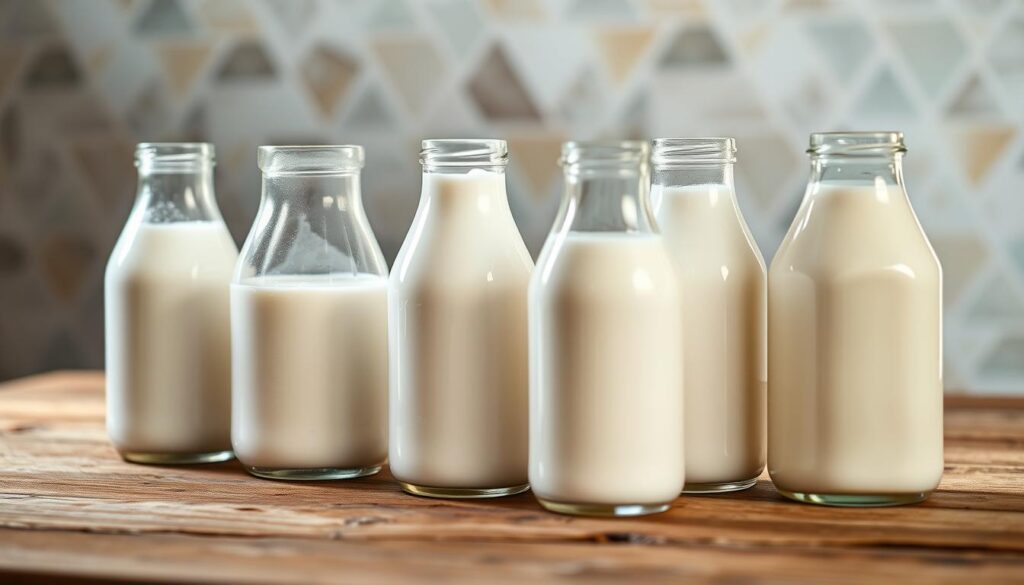
Each milk variety adds something special to your brioche dough. Knowing these differences can lead to tastier and more consistent brioche.
Whole Milk: The Gold Standard
Whole milk is the top pick for most brioche recipes. It has:
- Enhanced flavor complexity
- Improved dough tenderness
- Richer golden-brown crust
- More luxurious mouthfeel
Low-Fat Milk Alternatives
Low-fat milk can also make great brioche rolls. But, it might make the bread slightly less tender.
Non-Dairy Options for Diverse Dietary Needs
For those with dietary restrictions, there are other milk options:
- Almond milk
- Oat milk
- Soy milk
- Coconut milk
“The secret to great brioche is understanding how different milk types interact with your ingredients.” – Professional Baker
Non-dairy milks offer unique flavors and textures. Try different ones to find your favorite!
Effects of Temperature on Milk in Dough
When making milk brioche rolls, the milk’s temperature is key. It affects the dough’s texture and rise. Knowing how temperature impacts your baking can make your brioche rolls truly special.
The milk’s temperature is crucial for yeast activation and dough fermentation. Bakers say the right temperature is essential for success.
Warm Milk and Yeast Activation
Warm milk is a must for yeast to work well in brioche rolls. The best temperature is between 100-110 degrees Fahrenheit. At this temperature, yeast works its best:
- Promotes faster rising of the dough
- Enhances gluten development
- Creates a more uniform texture in brioche rolls
For your milk brioche rolls, use 3/4 cup of warm milk (about 177 ml) and 1 1/2 teaspoons of dry active yeast. This mix helps your dough rise well.
Cold Milk and Dough Fermentation
Cold milk changes the game for brioche rolls. It slows down fermentation, letting flavors deepen. Bakers use cold milk for:
- Controlled, slower rising process
- Enhanced flavor complexity
- More developed gluten structure
Trying different milk temperatures can help you create the perfect brioche rolls. It’s all about finding what works best for you.
Milk Lactose and Flavor Complexity
Creating a tasty milk brioche recipe means knowing how milk lactose works. It turns your sweet brioche bun into something special. The natural sugars in milk add a depth of flavor that excites your taste buds.
Sweetness and Aroma Dynamics
Lactose adds a soft sweetness that blends well with other sugars. Your milk brioche recipe might use about 1/4 cup of sugar. This sugar, along with milk’s natural sugars, makes the flavor rich and complex.
- Milk lactose provides gentle sweetness
- Natural sugars enhance overall taste complexity
- Balanced sweetness creates depth in brioche rolls
Fermentation and Flavor Development
During fermentation, milk lactose changes in amazing ways. Yeast breaks down these sugars, making unique aromatic compounds. These compounds give brioche its special taste.
The magic of brioche lies in its ability to capture subtle flavor nuances through careful milk and sugar interactions.
Learning about lactose’s role in flavor can help you make amazing sweet brioche buns. These buns will wow anyone who tries them.
Milk in Milk Brioche Roll Recipes
Making milk brioche rolls is all about precision and passion. These soft, buttery treats turn simple ingredients into amazing baked goods. They can take your cooking to the next level, whether you’re a pro or just starting out.
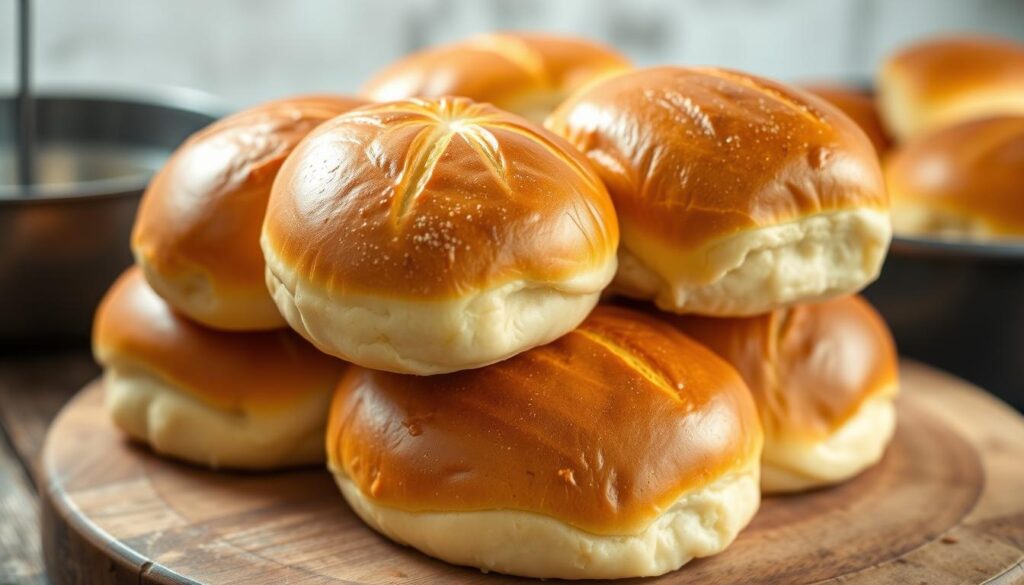
Now, let’s explore the world of milk brioche rolls. We’ll look at classic and creative recipes that will make your taste buds dance.
Classic Milk Brioche Roll Recipe
A traditional milk brioche roll recipe needs careful attention to ingredients and technique. Here’s what you’ll need:
- 3/4 cup warm milk
- 1 1/2 teaspoons dry active yeast
- 1/4 cup plus 1 tablespoon sugar
- 4 cups all-purpose flour
- 1 teaspoon salt
- 3 large eggs
- 1/2 cup unsalted butter
Exciting Variations and Twists
Once you’ve got the classic recipe down, try these creative twists:
- Brioche Hot Cross Buns: Add dried fruits and spices
- Brioche Donuts: Shape and deep fry for a decadent treat
- Brioche French Toast: Use day-old rolls for a luxurious breakfast
“The secret to perfect milk brioche rolls is patience and love in every step of the process.” – Artisan Baker
Don’t be afraid to experiment with your milk brioche roll recipe. Try different milk-to-flour ratios and unique flavors. Remember, practice makes perfect!
Milk Substitutions for Dietary Needs
Making delicious milk brioche rolls doesn’t mean you have to skip out on dietary needs. If you’re lactose intolerant or prefer a plant-based diet, there are great milk substitutes. These can help you make amazing brioche rolls.
Choosing the right milk substitute can change your milk brioche recipe. It keeps the rich texture and flavor of classic brioche rolls.
Lactose-Free Milk Options
Lactose-free milk is perfect for those with dairy sensitivities. It has:
- Identical protein content to regular milk
- Similar moisture retention properties
- Comparable texture in brioche rolls
- Enzyme-treated to remove lactose
Plant-Based Milk Alternatives
Plant-based milks can replace traditional dairy in your brioche rolls. Here are some options:
| Milk Alternative | Flavor Impact | Protein Content |
|---|---|---|
| Soy Milk | Neutral | High protein |
| Almond Milk | Subtle nutty | Low protein |
| Oat Milk | Creamy | Moderate protein |
When using milk substitutes in your brioche rolls, adjust the liquid ratios. You might also need to add extra fat to keep the richness. Try different alternatives to find your ideal milk brioche recipe.
Pro tip: Always choose unsweetened milk alternatives to control the sweetness of your brioche rolls.
Common Mistakes When Using Milk
Making perfect milk brioche rolls needs precision and knowing key baking techniques. Even skilled bakers face challenges with milk in their recipes. Knowing and avoiding common mistakes can greatly improve your baking.
Mastering milk brioche rolls means understanding how ingredients, like milk, work together. Success depends on avoiding mistakes that can ruin the texture and taste of your rolls.
Temperature Troubles with Milk
Temperature is key for making great milk brioche rolls. Using milk at the wrong temperature can affect your baking:
- Cold milk can slow down yeast activation
- Milk that’s too hot can kill active yeast
- Ideal milk temperature ranges between 100-110°F (37-43°C)
Mixing Mistakes to Avoid
The mixing process affects the texture of your brioche rolls. It’s important to know the right mixing techniques:
- Under-mixing leads to uneven dough development
- Over-mixing can develop excess gluten, creating tough rolls
- Follow recipe instructions for precise mixing times
| Mistake | Consequence | Solution |
|---|---|---|
| Cold Milk | Slow Yeast Activation | Warm milk to 105°F |
| Over-mixing | Tough Texture | Mix until just combined |
| Under-mixing | Uneven Dough | Knead until smooth |
Pro tip: Always use a kitchen thermometer to check milk temperature. Also, watch your dough’s consistency during mixing for perfect milk brioche rolls every time.
Conclusion: The Importance of Milk in Brioche
Milk brioche rolls are a culinary journey that turns simple ingredients into amazing bread. Learning about milk’s role in baking can make your cooking skills better. The way milk works with flour, yeast, and butter makes each batch of brioche rolls special.
Every milk brioche roll is a story of care and dedication. By learning how to mix warm milk, control fermentation, and measure ingredients, you can make rolls that are both healthy and tasty. The right mix of 3/4 cup warm milk and other ingredients makes the bread soft, rich, and delicious.
Final Thoughts on Baking with Milk
Your baking journey is just starting. Try different milks, temperatures, and methods to find your own way of making brioche rolls. Milk brioche rolls are great for breakfast or dinner, and they can be used in many ways. Always remember, practice, patience, and a love for learning are key in the kitchen.
Encouraging Experimentation in the Kitchen
Don’t be afraid to try new things with milk brioche rolls. Swap out different milks, change how long you let them ferment, and add new flavors. Your own twist can turn a classic recipe into something truly special that shows off your creativity and love for baking.
FAQ
What makes milk brioche rolls different from regular bread rolls?
Milk brioche rolls are known for their soft, tender texture and rich taste. The high milk content makes the crumb softer and more delicate than regular rolls. This unique moisture and richness set them apart.
Can I use different types of milk in my brioche recipe?
Yes, you can try different milks like whole, low-fat, or non-dairy options. But whole milk is best for the soft, rich texture. If you use other milks, you might need to adjust the recipe a bit.
How does milk impact the texture of brioche rolls?
Milk is key to brioche rolls’ softness. It helps build gluten and makes the crumb tender. It also keeps the rolls moist and adds a touch of sweetness.
What is the ideal milk temperature for making brioche dough?
The milk should be warm, around 110°F (43°C). This warm temperature is important for yeast activation and dough fermentation. It helps in developing flavor and rise.
Are there lactose-free options for making milk brioche rolls?
Yes, you can use lactose-free milk or plant-based milks like almond, soy, or oat. You might need to tweak the recipe for fat and protein differences. These alternatives can still make delicious brioche rolls, but they might taste slightly different.
What are the most common mistakes when making milk brioche rolls?
Mistakes include wrong milk temperature, over or under mixing, and not enough fermentation time. Wrong temperature can harm yeast, and bad mixing affects gluten. Always follow the recipe for the best results.
How does the fat content in milk affect brioche rolls?
The fat in milk makes brioche rolls rich and creamy. Whole milk, with more fat, gives a luxurious texture. This is why it’s often used in traditional recipes.
Can I make milk brioche rolls ahead of time?
Yes, you can make the dough ahead and refrigerate it overnight for better flavor. You can also freeze unbaked rolls and thaw them before baking. Store baked rolls in an airtight container for 2-3 days or freeze for longer.

